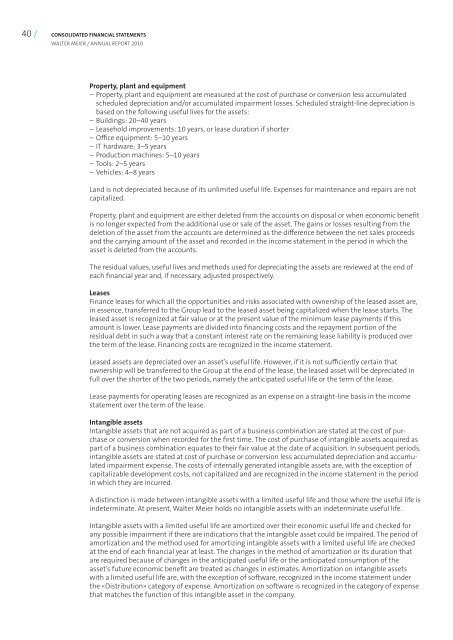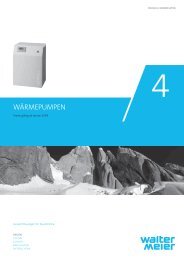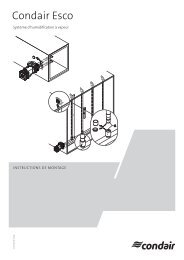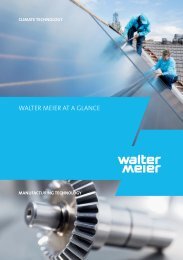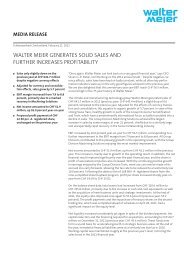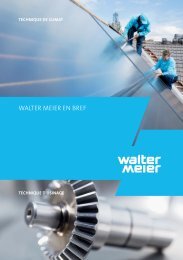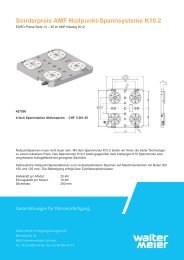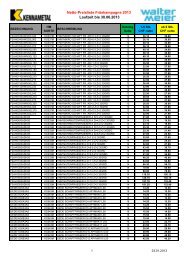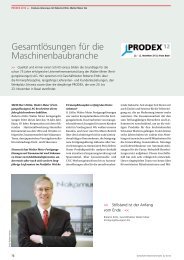AnnuAl report 2010 - Walter Meier
AnnuAl report 2010 - Walter Meier
AnnuAl report 2010 - Walter Meier
You also want an ePaper? Increase the reach of your titles
YUMPU automatically turns print PDFs into web optimized ePapers that Google loves.
40 / Consolidated FinanCial statements<br />
<strong>Walter</strong> <strong>Meier</strong> / annual <strong>report</strong> <strong>2010</strong><br />
Property, plant and equipment<br />
– property, plant and equipment are measured at the cost of purchase or conversion less accumulated<br />
scheduled depreciation and/or accumulated impairment losses. Scheduled straight-line depreciation is<br />
based on the following useful lives for the assets:<br />
– Buildings: 20–40 years<br />
– leasehold improvements: 10 years, or lease duration if shorter<br />
– office equipment: 5–10 years<br />
– it hardware: 3–5 years<br />
– production machines: 5–10 years<br />
– tools: 2–5 years<br />
– Vehicles: 4–8 years<br />
land is not depreciated because of its unlimited useful life. expenses for maintenance and repairs are not<br />
capitalized.<br />
property, plant and equipment are either deleted from the accounts on disposal or when economic benefit<br />
is no longer expected from the additional use or sale of the asset. the gains or losses resulting from the<br />
deletion of the asset from the accounts are determined as the difference between the net sales proceeds<br />
and the carrying amount of the asset and recorded in the income statement in the period in which the<br />
asset is deleted from the accounts.<br />
the residual values, useful lives and methods used for depreciating the assets are reviewed at the end of<br />
each financial year and, if necessary, adjusted prospectively.<br />
leases<br />
Finance leases for which all the opportunities and risks associated with ownership of the leased asset are,<br />
in essence, transferred to the Group lead to the leased asset being capitalized when the lease starts. the<br />
leased asset is recognized at fair value or at the present value of the minimum lease payments if this<br />
amount is lower. lease payments are divided into financing costs and the repayment portion of the<br />
residual debt in such a way that a constant interest rate on the remaining lease liability is produced over<br />
the term of the lease. Financing costs are recognized in the income statement.<br />
leased assets are depreciated over an asset’s useful life. However, if it is not sufficiently certain that<br />
ownership will be transferred to the Group at the end of the lease, the leased asset will be depreciated in<br />
full over the shorter of the two periods, namely the anticipated useful life or the term of the lease.<br />
lease payments for operating leases are recognized as an expense on a straight-line basis in the income<br />
statement over the term of the lease.<br />
intangible assets<br />
intangible assets that are not acquired as part of a business combination are stated at the cost of purchase<br />
or conversion when recorded for the first time. the cost of purchase of intangible assets acquired as<br />
part of a business combination equates to their fair value at the date of acquisition. in subsequent periods,<br />
intangible assets are stated at cost of purchase or conversion less accumulated depreciation and accumulated<br />
impairment expense. the costs of internally generated intangible assets are, with the exception of<br />
capitalizable development costs, not capitalized and are recognized in the income statement in the period<br />
in which they are incurred.<br />
a distinction is made between intangible assets with a limited useful life and those where the useful life is<br />
indeterminate. at present, <strong>Walter</strong> <strong>Meier</strong> holds no intangible assets with an indeterminate useful life.<br />
intangible assets with a limited useful life are amortized over their economic useful life and checked for<br />
any possible impairment if there are indications that the intangible asset could be impaired. the period of<br />
amortization and the method used for amortizing intangible assets with a limited useful life are checked<br />
at the end of each financial year at least. the changes in the method of amortization or its duration that<br />
are required because of changes in the anticipated useful life or the anticipated consumption of the<br />
asset’s future economic benefit are treated as changes in estimates. amortization on intangible assets<br />
with a limited useful life are, with the exception of software, recognized in the income statement under<br />
the «Distribution» category of expense. amortization on software is recognized in the category of expense<br />
that matches the function of this intangible asset in the company.


